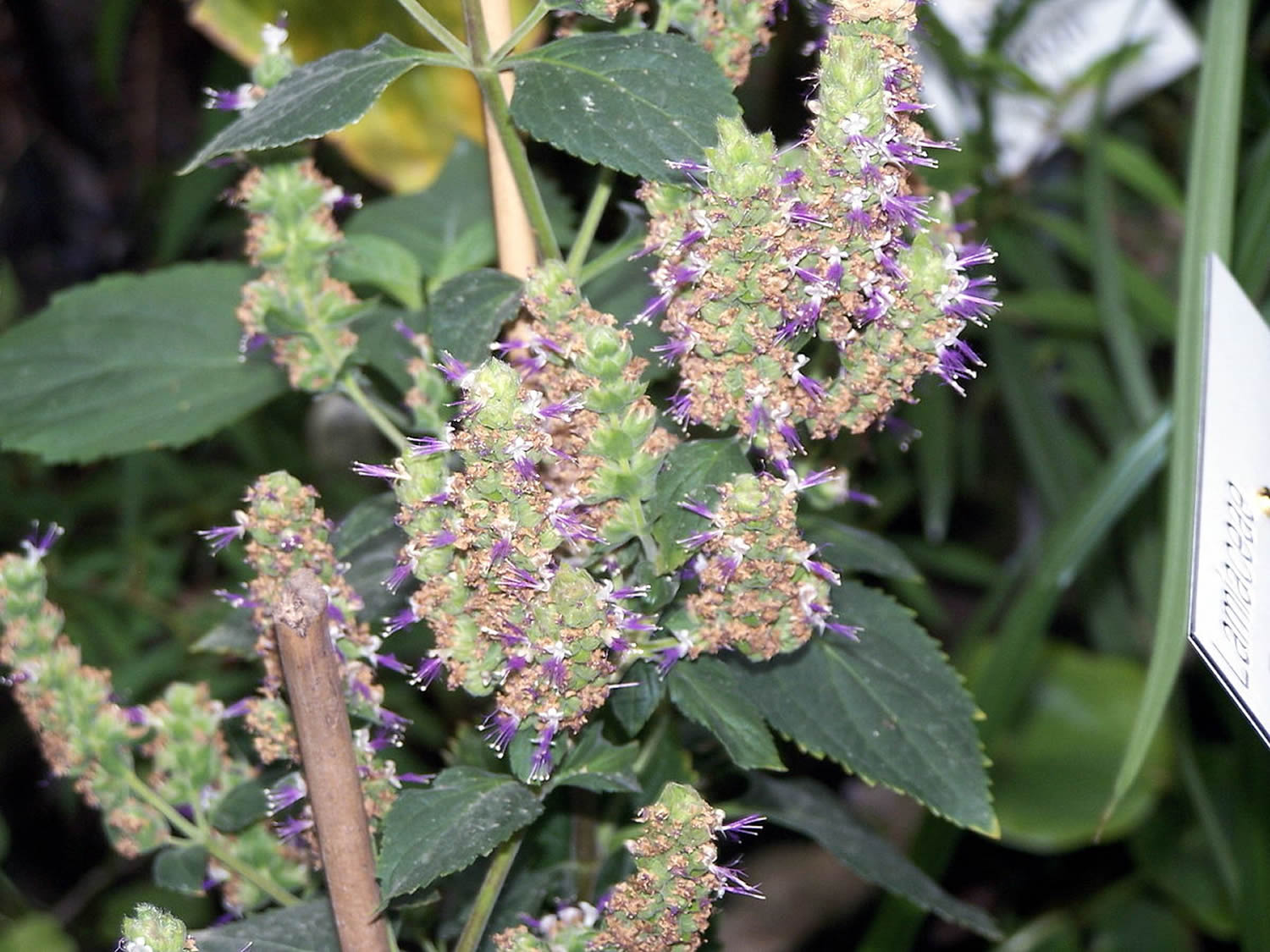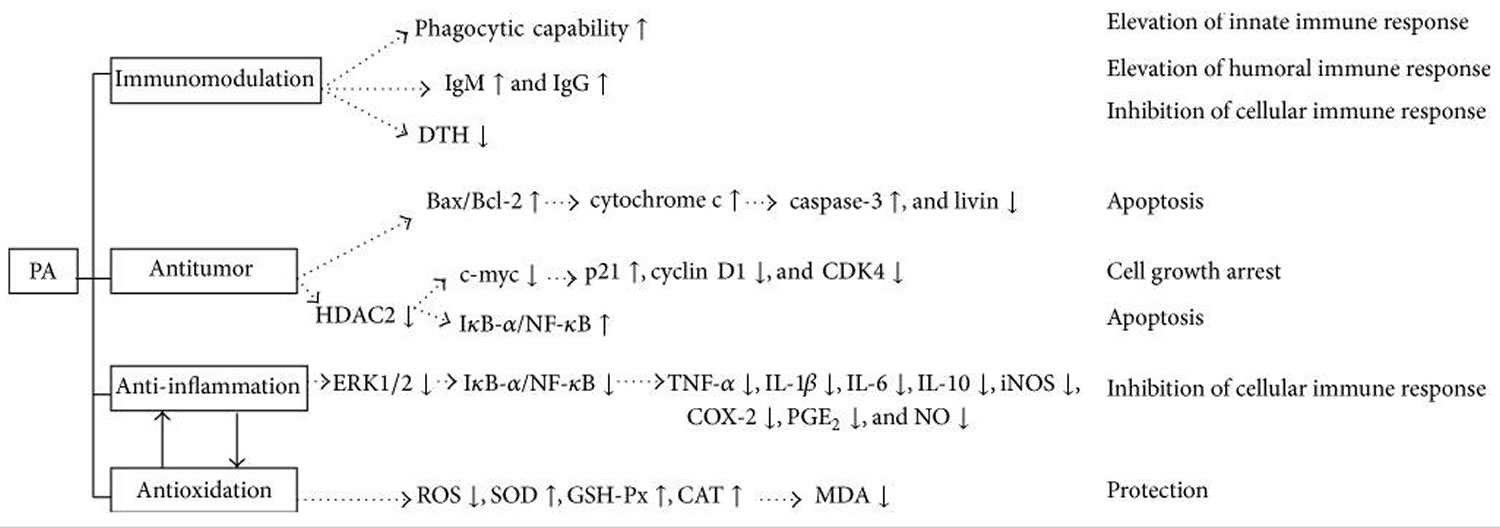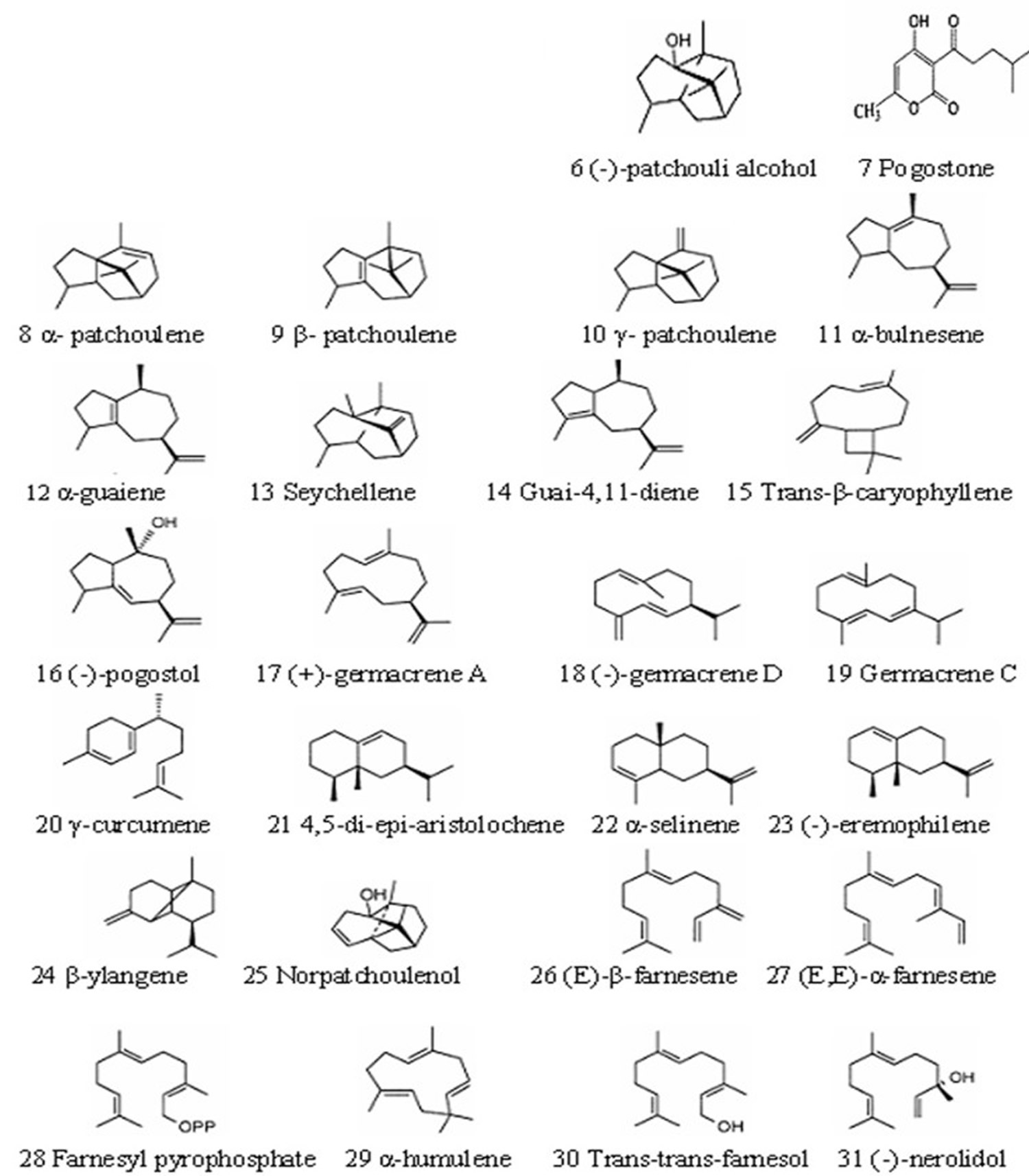What is patchouli
Patchouli (Pogostemon cablin) is commonly known as “guanghuoxiang” in Chinese, is a bushy herb that is a member of the mint family (Lamiaceae), with erect stems, reaching around 75 centimetres (2.5 ft) in height and bearing small, pale pink-white flowers 1. A strong-smelling oil taken from the patchouli leaves is used in perfumes, incense, detergents, insect repellents and hair conditioners. It has been used in some cultures as alternative medicines to prevent disease.
Patchouli (Pogostemon cablin) is traditionally used in China to treat various illnesses, including fever, common cold, diarrhea and nausea 2. Previous studies have demonstrated that Patchouli also exerts numerous bioactivities, including radical-scavenging, anti-microbial, analgesic and anti-inflammatory activities 3. Several studies have been carried out on the composition of Patchouli (Pogostemon cablin) and the presence of patchouli alcohol, pogostone, eugenol, α-bulnesene, rosmarinic acid, etc. has been revealed 4. Patchouli essential oils constitute about 1.5% of Patchouli and among them >50% is patchouli alcohol 5. Patchouli alcohol (see Figure 2), which is a tricyclic sesquiterpene, is the main active ingredient of Patchouli 6. Oral administration of Patchouli alcohol has been demonstrated to offer protection against influenza virus infection in mice via the enhancement of host immune responses, and the attenuation of systemic and pulmonary inflammatory responses 7. In addition, it has been reported that pretreatment with Patchouli alcohol attenuates reactive oxygen species (ROS) generation following Aβ25–35-induced toxicity 8. These findings indicated that Patchouli alcohol possesses anti-inflammatory and antioxidative activities 9. Patchouli alcohol has an oral median lethal dose value of 4,693 mg/kg in mice 10.
Figure 1. Patchouli
Patchouli alcohol
Patchouli alcohol (C15H26O), a naturally occurring tricyclic sesquiterpene, is the critically biological active constituent among the patchouli oil extracted from Patchouli and usually used as a pivotal chemical marker compound for the assessments in quality control of Pogostemonis Herba and patchouli oil in China 1. However, the practices of using Patchouli alcohol are blank in medical field, despite Patchouli alcohol has been demonstrated in test tube studies to possess multibeneficial pharmacological properties, such as immunomodulatory, anti-inflammatory, antioxidative, antitumor, antimicrobial, insecticidal, antiatherogenic, antiemetic, whitening, and sedative activities 1.
In nature, Patchouli alcohol primarily exists in volatile oil of Patchouli and its contents are about 48.8% 11. In general, Patchouli alcohol contents were higher in the leaves than that in the root and/or stem and altered in different collection parts as well as harvest times. Patchouli alcohol is also detected within volatile oil from other plants, such as Herba Lysimachia paridiformis (22.54%) 12, Rhizoma Valeriana jatamansi jones (5.88%) 13, Rhizoma Nardostachys chinensis (4.5%) 14, Radix Mallotus apelta (4.48%) 15, Foliage Ficus microcarpa (4.05%) 16, Herba Pholidota cantonensis (3.60%) 17, Herba Asarum sieboldii (2.75%) 18, Herba Gendarussa vulgaris (2.68%) 19, Radix Helleborus thibetanus (0.811%) 20, Herba Sedum sarmentosum (0.53%) 21, Aquilaria agallocha (0.392%) 22, Pericardium Citri reticulatae (China: Xinhui, 0.178%; Guangxi, 0.162%; and Fujian, 0.086%) 23, Fructus Periploca forrestii Schltr. (MAE, 0.12%; and SDE, 6012%) 24, and Foliage Microtoena patchouli 25.
Figure 2. Patchouli alcohol chemical structure
[Source 26]Figure 3. Possible mechanisms of bioactivities of Patchouli alcohol in immunomodulation, antitumor, anti-inflammation, and antioxidation
Note: Arrow up denotes activation or increase; arrow down denotes suppression or decrease. Inflammation and oxidation interact with each other.
[Source 1]The present information exhibited remarkably therapeutic properties of Patchouli Alcohol in vivo (animal) and in vitro (test tube) studies, which could contribute to the prevention and treatment of many diseases, such as immune disorders, infections by microbes, mosquitoes or Trypanosoma cruzi, ALI, mastitis, gastric ulcer, skin photoaging, atherosclerosis, and tumor. However, further studies are required to investigate the safety and toxicity Patchouli alcohol in both animals and humans. And so far there has been no well designed human clinical trials to support the purported benefits of Patchouli, Patchouli alcohol or Patchouli essential oil. Finally, any medicinal benefit of Patchouli remains unclear.
Patchouli essential oil
The dry leaves of patchouli on steam distillation, requiring rupture of its cell walls by steam scalding, light fermentation, or drying to yield an essential oil called the patchouli oil. Patchouli essential oil is hence an important ingredient in many fine fragrance products such as perfumes, as well as in soaps and cosmetic products 27. Results of High Performance Thin Layer Chromatography studies indicated that the ethyl acetate extract of Patchouli leaves included triterpenes, as 10 and 14 peaks of ultra violet (UV) absorption were observed in 254 nm and 366 nm, respectively. Hence, triterpenes may be responsible for antidermatophytic activity of this plant 28.
Moreover, patchouli oil in the plant is widely used in Traditional Chinese Medicine as it offers various types of pharmacological activities 29. It has also been reported to strengthen the immune activity and resistance to bacterial action 30. The composition of the patchouli oil is complex like many essential oils, which consist of the major components such as patchoulol alcohol and pogostone etc. The mechanism of action of major pharmacologic components in patchouli oil as an antibacterial agent has not been reported. However, in an in-vitro (test tube) study, the main compounds in patchouli essential oil seems to be patchouli alcohol and pogostone, whose composition exceeded 60% (g/g) in patchouli oil samples – all have good antibacterial activities 31.
Figure 4. 26 chemical compounds in Patchouli oil
[Source 31]Patchouli oil uses
Perfume
Patchouli oil is an important essential oil in the perfume industry, keeping a base and lasting character to a fragrance. For characteristic pleasant and long lasting woody and camphoraceous odor, patchouli oil is appreciated and very suitable for the utilization of decorative cosmetics, fragrances, shampoo, toilet soaps, paper towels, air fresheners and other toiletries as well as noncosmetic products such as household cleaners and detergents 1.
Insect repellent
One study suggests that patchouli oil may serve as an all-purpose insect repellent 32. More specifically, the patchouli plant is claimed to be a potent repellent against the Formosan subterranean termite 33. The experiment on repellent and toxic effects of Patchouli alcohol on Coptotermes formosanus Shiraki (Isoptera: Rhinotermitidae) was carried out by Zhu et al. 34. The results uncovered that patchouli alcohol pretreatment resulted in elevation in mortality percentage and decline in termites feeding, contacting and tunneling behaviors, and particularly the internal tissue of termites was destructed inside the exoskeleton when patchouli alcohol was topically applied into the dorsum. Furthermore, patchouli alcohol was witnessed to have obvious repellency and toxicity towards mosquitoes. Patchouli alcohol, at 2 mg/cm2 concentration, was the most effective for repellent activity, providing 100% protection up to 280 min, against Ae aegypti, An. Stephensi, and Cx. quinquefasciatus, and for pupicidal activity at 100 mg/L concentration, providing 28.44, 26.28, and 25.36 against above vector mosquitoes tested 35. These findings provide experimental basis for the development of patchouli alcohol as an ideal eco-friendly pesticide for the control of termites and mosquitoes.
Incense
Patchouli is an important ingredient in East Asian incense. Both patchouli oil and incense underwent a surge in popularity in the 1960s and 1970s in the US and Europe, mainly as a result of the hippie movement of those decades 36.
Culinary
Patchouli leaves have been used to make an herbal tea. In some cultures, patchouli leaves are eaten as a vegetable or used as a seasoning.
- Hu G, Peng C, Xie X, Zhang S, Cao X. Availability, Pharmaceutics, Security, Pharmacokinetics, and Pharmacological Activities of Patchouli Alcohol. Evidence-based Complementary and Alternative Medicine : eCAM. 2017;2017:4850612. doi:10.1155/2017/4850612. https://www.ncbi.nlm.nih.gov/pmc/articles/PMC5379095/[↩][↩][↩][↩][↩]
- Oral administration of patchouli alcohol isolated from Pogostemonis Herba augments protection against influenza viral infection in mice. Li YC, Peng SZ, Chen HM, Zhang FX, Xu PP, Xie JH, He JJ, Chen JN, Lai XP, Su ZR. Int Immunopharmacol. 2012 Jan; 12(1):294-301. https://www.ncbi.nlm.nih.gov/pubmed/22193241/[↩]
- Pogostemon cablin as ROS Scavenger in Oxidant-induced Cell Death of Human Neuroglioma Cells. Kim HW, Cho SJ, Kim BY, Cho SI, Kim YK. Evid Based Complement Alternat Med. 2010 Jun; 7(2):239-47. https://www.ncbi.nlm.nih.gov/pmc/articles/PMC2862928/[↩]
- Alpha-bulnesene, a novel PAF receptor antagonist isolated from Pogostemon cablin. Hsu HC, Yang WC, Tsai WJ, Chen CC, Huang HY, Tsai YC. Biochem Biophys Res Commun. 2006 Jul 7; 345(3):1033-8. https://www.ncbi.nlm.nih.gov/pubmed/16712790/[↩]
- Kim HW, Cho SJ, Kim B-Y, Cho SI, Kim YK. Pogostemon cablin as ROS Scavenger in Oxidant-induced Cell Death of Human Neuroglioma Cells. Evidence-based Complementary and Alternative Medicine : eCAM. 2010;7(2):239-247. doi:10.1093/ecam/nem176. https://www.ncbi.nlm.nih.gov/pmc/articles/PMC2862928/[↩]
- Xian YF, Li YC, Ip SP, Lin ZX, Lai XP, Su ZR. Anti-inflammatory effect of patchouli alcohol isolated from Pogostemonis Herba in LPS-stimulated RAW264.7 macrophages. Exp Ther Med. 2011;2:545–550. https://www.ncbi.nlm.nih.gov/pmc/articles/PMC3440699/[↩]
- Li YC, Peng SZ, Chen HM, Zhang FX, Xu PP, Xie JH, He JJ, Chen JN, Lai XP, Su ZR. Oral administration of patchouli alcohol isolated from Pogostemonis Herba augments protection against influenza viral infection in mice. Int Immunopharmacol. 2012;12:294–301. doi: 10.1016/j.intimp.2011.12.007.[↩]
- Huang XW, Bai L, Xu FH, Wu YJ. Inhibitory activities of patchouli alcohol on neurotoxicity of β-amyloid peptide. Jie Fang Jun Yi Xue Za Zhi. 2008;24:338–340.[↩]
- SU Z, LIAO J, LIU Y, et al. Protective effects of patchouli alcohol isolated from Pogostemon cablin on lipopolysaccharide-induced acute lung injury in mice. Experimental and Therapeutic Medicine. 2016;11(2):674-682. doi:10.3892/etm.2015.2918. https://www.ncbi.nlm.nih.gov/pmc/articles/PMC4733951/[↩]
- Anti-inflammatory activity of patchouli alcohol isolated from Pogostemonis Herba in animal models. Li YC, Xian YF, Ip SP, Su ZR, Su JY, He JJ, Xie QF, Lai XP, Lin ZX. Fitoterapia. 2011 Dec; 82(8):1295-301. https://www.ncbi.nlm.nih.gov/pubmed/21958968/[↩]
- Huang L., Wu H., Zhang G., et al. Analysis of supercritical CO2 extraction products from Herba Pogostemonis by GC-MS. Journal of Instrumental Analysis. 2001;20(4):79–81.[↩]
- Zhou X., Liang G., Wang D., Xu B. Study on the chemical constituents of the volatile oil from Lysimachia trientaloides Hemsl. Chinese Journal of Chromatography. 2002;20(3):286–288.[↩]
- Wang H., Wan X., Yan X., et al. Chemical constituents of supercritical CO2 extract from Valeriana jatamansi. Journal of Beijing University of Traditional Chinese Medicine. 2007;30(12):832–835.[↩]
- Tanaka K., Komatsu K. Comparative study on volatile components of Nardostachys Rhizome. Journal of Natural Medicines. 2008;62(1):112–116. doi: 10.1007/s11418-007-0199-7.[↩]
- Li J., Chen F., Lv Z. Study on volatile ingredients of Mallotus apelta (Lour) Traditional Chinese Medicine. 2003;26(10):723–724.[↩]
- Li Y., Wang W., Sun Z., et al. Study on volatile components of Foliage Ficus microcarpa. China Journal of Chinese Materia Medica. 2008;33(1):87–88.[↩]
- Li K., Lu Y., Gu X., Kang W. Analysis of volatile components in the aerial parts of Pholidota cantonensis by HS-SPME-GC-MS. China Pharmacy. 2012;23(35):3319–3320.[↩]
- Yuan S., Wei J., Lin H. Analysis on chemical components of volatile oil of Yichang Asarum sieboldii by GC/ MS. China Journal of Chinese Materia Medica. 2004;29(3):p. 280.[↩]
- Su L., Cai Y., Zhu H., Zhu Y., Li X. Analysis on chemical components of volatile oil of Gendarussa vulgaris by GC/ MS. Journal of Guangxi Traditional Chinese Medical University. 2009;12(2):56–58.[↩]
- Gao Y., Jin F., Wang X., Qian H., Li Y. Analysis on volatile components of Helleborus thibetanus by GC/MS. Lishizhen Medicine and Materia Medical Research. 2011;22(1):122–123.[↩]
- Han R., Wang B. Study on the chemical constituents of the essential oil from Sedum sarmentosum Bunge. Journal of Liaoning University of TCM. 2007;9(3):73–74.[↩]
- Deng H., Tong H., Zhou R. SFE-CO2 and GC-MS analysis of the essential oil from Chinese Eaglewood. West China Journal of Pharmaceutical Sciences. 2008;23(6):633–635.[↩]
- Zhou X., Huang Q., Liao S., Mo Y., Chen S. Analysis on volatile oil of Pericarpium Citri Reticulatae from different areas by GC/MS. Pharmacy Today. 2009;19(4):43–45.[↩]
- Hu X., Zhou X., Li M., Liu H., Zhou W. Analysis on chemical constituents of volatile oil of the fruit of Periploca forrestii Schltr. Journal of Instrumental Analysis. 2007;26:160–163.[↩]
- Ito K., Ito M. Sedative effects of vapor inhalation of the essential oil of Microtoena patchoulii and its related compounds. Journal of Natural Medicines. 2011;65(2):336–343. doi: 10.1007/s11418-010-0502-x.[↩]
- Patchouli alcohol. https://pubchem.ncbi.nlm.nih.gov/compound/Patchouli_alcohol[↩]
- Singh M, Sharma S, Ramesh S. oil yield and oil quality of patchouli [Pogostemon cablin (Blanco) Benth.] influenced by irrigation, organic mulch and nitrogen application in semi-arid tropical climate. Ind. Crop. Prod. 2002;16:101–107.[↩]
- Antidermatophytic Activity of Pogostemon parviflorus Benth. Sadeghi-Nejad B, Sadhu Deokule S. Iran J Pharm Res. 2010 Summer; 9(3):279-85. https://www.ncbi.nlm.nih.gov/pmc/articles/PMC3863443/[↩]
- Donelian A, Carlsonb LHC, Lopes TJ, Machado RAF. Comparison of extraction of patchouli (Pogostemon cablin) essential oil with supercritical CO2 and by steam distillation. J. Super. Flui. 2009;48:15–20.[↩]
- GC-MS fingerprint of Pogostemon cablin in China. Hu LF, Li SP, Cao H, Liu JJ, Gao JL, Yang FQ, Wang YT. J Pharm Biomed Anal. 2006 Sep 18; 42(2):200-6. https://www.ncbi.nlm.nih.gov/pubmed/16242880/[↩]
- Yang X, Zhang X, Yang S-P, Liu W-Q. Evaluation of the Antibacterial Activity of Patchouli Oil. Iranian Journal of Pharmaceutical Research : IJPR. 2013;12(3):307-316. https://www.ncbi.nlm.nih.gov/pmc/articles/PMC3813264/[↩][↩]
- Trongtokit, Y., Rongsriyam, Y., Komalamisra, N. and Apiwathnasorn, C. (2005), Comparative repellency of 38 essential oils against mosquito bites. Phytother. Res., 19: 303–309. doi:10.1002/ptr.1637 http://onlinelibrary.wiley.com/doi/10.1002/ptr.1637/epdf[↩]
- Toxicity and Repellency of Patchouli Oil and Patchouli Alcohol against Formosan Subterranean Termites Coptotermes formosanus Shiraki (Isoptera: Rhinotermitidae). J. Agric. Food Chem., 2003, 51 (16), pp 4585–4588. http://pubs.acs.org/doi/full/10.1021/jf0301495[↩]
- Toxicity and repellency of patchouli oil and patchouli alcohol against Formosan subterranean termites Coptotermes formosanus Shiraki (Isoptera: Rhinotermitidae). Zhu BC, Henderson G, Yu Y, Laine RA. J Agric Food Chem. 2003 Jul 30; 51(16):4585-8. https://www.ncbi.nlm.nih.gov/pubmed/14705881/[↩]
- Gokulakrishnan J., Kuppusamy E., Shanmugam D., Appavu A., Kaliyamoorthi K. Pupicidal and repellent activities of Pogostemon cablin essential oil chemical compounds against medically important human vector mosquitoes. Asian Pacific Journal of Tropical Disease. 2013;3(1):26–31. doi: 10.1016/s2222-1808(13)60006-7.[↩]
- Foster, Steven; Johnson, Rebecca L. (2006). Desk Reference to Nature’s Medicine. Washington, D.C.: National Geographic Society. p. 282. ISBN 978-0-7922-3666-5.[↩]








